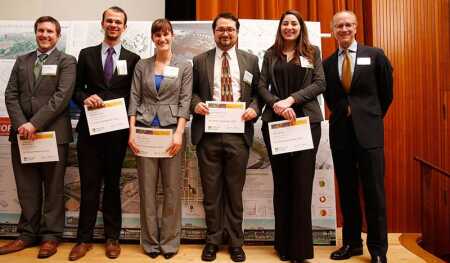For a second consecutive year, a team representing the University of Maryland has taken top honors in the 2015 Urban Land Institute (ULI) Hines Competition with its winning master plan proposal that transforms the Tulane/Gravier and Iberville neighborhoods in downtown New Orleans into a thriving urban neighborhood. The team from the University of Maryland edged out two teams from Harvard University and a joint team representing the University of Wisconsin–Milwaukee and the University of Wisconsin–Madison.
As the winning team, the University of Maryland students received $50,000; each of the remaining three finalist teams received $10,000. The announcement was made at the competition’s conclusion yesterday in New Orleans.
The ideas competition challenged multidisciplinary student teams with the task of devising a comprehensive design and development program for parts of the Tulane/Gravier and Iberville neighborhoods. This year’s competition was designed to simulate an actual urban design and development scenario, with certain details changed for the purposes of the competition. The competition scenario was based on a hypothetical situation in which community stakeholders—including residents, landowners, local businesses, and others in the area bound by the upcoming Lafitte Greenway, the eastern edge of the new medical district, and crossed by the elevated I-10 highway—came together to create the North Claiborne Neighborhood Improvement Association (NCNIA), a fictional entity created for the purpose of the competition, which sought to convert the site into a thriving community that blends with the culture and economy of the surrounding area.
“The four student teams’ final proposals all made innovative yet financially realistic master plans for helping revive a historic downtown area ripe with market potential,” says J. Michael Pitchford, jury chairman and president and chief executive officer at CPDC in Silver Spring, Maryland. “When presented with an urban design assignment filled with critical land use challenges, each team stepped up and showed creative problem-solving skills. They will utilize these learned skills throughout their professions and go far in their careers.”
“The Crossing”—the winning proposal from the University of Maryland—fosters sensitive growth in Iberville, Bienville, and Lafitte by engaging the nearby medical campuses and the greenway. It develops a high-quality main street on Derbigny and phases in diverse housing stock at an appropriate urban scale. In the master plan, new development supports active programming under I-10, ensures affordable housing, and improves the area’s stormwater infrastructure. Final phases of the plan reinforce the community-oriented approach. A proposed bus rapid transit works to improve accessibility for historically disadvantaged communities along North Claiborne Avenue. The ramp relocation and subsequent redesign of Basin Street unify the Lafitte Greenway and Louis Armstrong Park. Within the newly continuous green space, the Resilience Center symbolizes the essence of the proposal by bringing locals and visitors together to create an improved future for the city and its residents.
The other finalist teams and development schemes included the following:
- Harvard University: “Claiborne Grove” recalls the rich landscape that once characterized North Claiborne Avenue. The proposal bridges the existing potential of the site with the positive momentum of the surrounding communities to create an energetic new residential and cultural center for all age groups.
- Harvard University: The “Tremé 2.0” project continues the Tremé neighborhood’s tradition of being the city’s trendsetter by reintroducing three new lifestyles in three themed corridors, woven together by a multilayered walkway system that allows visitors to engage in a modern interpretation of the traditional Vieux Carré courtyards and balconies.
- University of Wisconsin–Milwaukee and University of Wisconsin–Madison: “Quartier Vert” weaves together culturally rich neighborhoods, a substantial health care project, and a prevalent tourism industry through a vibrant, sustainable, neighborhood-based New Orleans development.
Established with a generous endowment from longtime ULI leader Gerald D. Hines, the competition strives to encourage cooperation and teamwork—necessary talents in the planning, design, and development of sustainable communities—among future land use professionals and allied professions, such as architecture, landscape architecture, urban planning, historic preservation, engineering, real estate development, finance, psychology, and law.
“The Hines Competition is the one ULI program that closely resembles the Institute’s core values of education, knowledge sharing, and an interdisciplinary approach,” says ULI Global Chief Executive Officer Patrick L. Phillips during the presentation. “The competition is really baked into the DNA of ULI and truly a reflection of what the organization is all about.”
This year, 120 teams comprising 600 students from 60 universities participated in the first round of the competition. The competition is open to graduate students who are pursuing real estate–related studies at universities in North America. The competition is designed as an exercise; there is no intention that the students’ plans will be implemented as part of any revitalization of the site.








